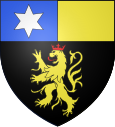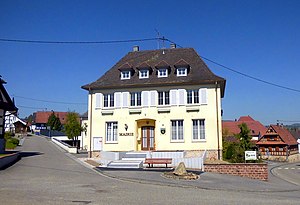Steinseltz
| Steinseltz | ||
|---|---|---|

|
|
|
| Country | France | |
| region | Grand Est | |
| Department (no.) | Bas-Rhin (67) | |
| Arrondissement | Haguenau-Wissembourg | |
| Canton | Wissembourg | |
| Community association | Pays de Wissembourg | |
| Coordinates | 49 ° 1 ′ N , 7 ° 56 ′ E | |
| height | 163- 252 m | |
| surface | 5.44 km² | |
| resident | 601 (January 1, 2018) | |
| Population density | 110 inhabitants / km² | |
| Post Code | 67160 | |
| INSEE code | 67479 | |
 Mairie Steinseltz |
||
Steinseltz (German Steinselz ) is a French commune with 601 inhabitants (as of January 1, 2018) in the Bas-Rhin department in the Grand Est region (until 2015 Alsace ). It is located on the edge of the Northern Vosges Natural Park .
story
The settlement was founded in the 8th century by the monk Dagobert from the Abbey of Weissenburg. The salt roads that led from Austria to the Netherlands and from Wissembourg to Saverne both passed the village. The current place name was derived from "rock salt" and thus from the salt pits of that time.
From 1871 until the end of the First World War , Steinseltz belonged to the German Empire as part of the realm of Alsace-Lorraine and was assigned to the Weißenburg district in the Lower Alsace district .
Population development
| year | 1910 | 1962 | 1968 | 1975 | 1982 | 1990 | 1999 | 2006 | 2017 |
| resident | 466 | 556 | 471 | 491 | 556 | 580 | 615 | 649 | 596 |
coat of arms
Description of coat of arms : In black a red-tongued and thus crowned golden lion ; The head of the shield is split in blue with a silver star and gold.
business
Agriculture mainly focuses on viticulture and fruit growing .
literature
- Le Patrimoine des Communes du Bas-Rhin. Flohic Editions, Volume 2, Charenton-le-Pont 1999, ISBN 2-84234-055-8 , p. 1594.


